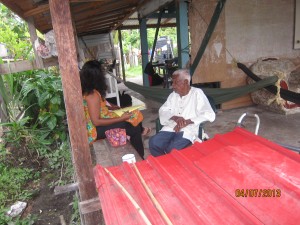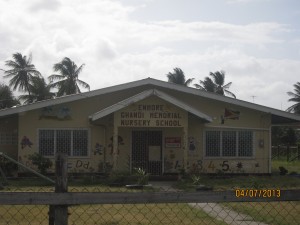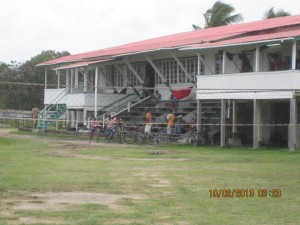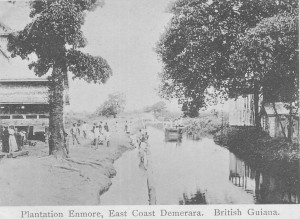By Deomattie Seeram

The village of Enmore, known during the 19th century as Plantation Enmore, plays an integral part in the history of Guyana. Located in Region Four, on the East Coast of Demerara, it is about two square miles, 16 miles away from the capital city Georgetown, and comprises about 3,000 residents.
Enmore, in the 19th Century, was primarily a cotton and sugar plantation, owned by Henry Porter. The estate became a community sometime in the late 1940s or early 1950s when villagers were granted plots of land. These plots of land were an upgrade from the primitive logies (mud huts) of the old village, which bunched together.
The village is well-known for the Enmore martyrs incident, which marked the turning point in industrial relations within the sugar industry and heralded the improvement of working conditions.
On Thursday, June 16, 1977, the Enmore Martyrs Monument was unveiled by the then Prime Minister Forbes Burnham on the occasion of the 29th anniversary of the death of the 5 gallant sugar workers. The monument stands raised on a concrete base six feet high with five repetitive verticals each adorned with brass symbols reminiscent of cutlasses and inscribed with the names of the 5 martyrs. There is also a plaque designed by Guyanese artist Stanley Greaves, cast by BACIF (Brass Aluminium and Cast Iron Foundry).
In the 1950s, Enmore steadily developed and within a decade, its population more than doubled.

In 1964, political strife between Indians and Africans emerged, and government and economy came to a standstill. Enmore was forced to segregate its people. This segregation was a result of the numerous riots, murders, vandalism, looting and civil disputes. Enmore was populated with a further one thousand refugees from neighbouring villages during these riots, and between 1964 and 1965 was able to satisfy the basic needs of the refugees, but became taxed and impoverished.
In 1970, a community centre was added under the control of Bookers’ Sugar Estate and soon after, community leaders were permitted control of the centre. Today, it is owned and operated by the community.
In 1992, Guyana became a democratic state with a change in government and ruling political party. Development in Enmore began again after twenty-eight years of stagnation.
But overpopulation had once again become a problem and the current government has begun selling lands east and west of Enmore to its residents, bringing relief to the overcrowded community.

In the beginning, the culture of Enmore resembled very much that of India, but as African and Chinese populated the village, a slight variety was added. After the 1964 riots, Enmore became an Indo-Guyanese village. However, over the years Indians lost their mother tongue and the English language, with a slight Creole touch, has replaced it.
Latchman Bissessar an eldery villager, 82, was born and grew up on the sugar estate. He recalled people on the plantation saying that Henry Porter was a kind person. He remembers that as a child growing up on the Estate everyone lived like one big family. No one referred to each other by name but as “maa”, “pita”, “chacha”, “chachee”, “didi”, and “bhai”.
Plantation life was very rough in the older days, and he remembers the logies, which his and other families lived, this made of wood, had a mud floor and a zinc roof. The logies were divided into rooms and each room was given to a family. They could not afford beds and so slept on the floor. They used latrines which were not private and more than one person went at a time- there were no bathrooms. Cooking was done on fireside. Water for drinking, cooking, washing and all other household chores had to be fetched from the trenches, through which sugar cane punts were channelled. This water, he recalled, was black water.
There was also a hospital that provided free medical services and a school for the children.

Bissessar started working on the sugar estate at 13, in the building and maintenance department at a daily rate of 48 cents. A few years after, he was told by the estate’s management that he was no longer needed in that department and was left with no other option but to cut cane. This work he said was very hard for him as he was not accustomed to it. He recalls the strike of 1948 to be a famous event where the workers completely stopped working on the estate. He said luckily for him, when the shooting took place, he was in Georgetown, but recalled the news spread like wild fire. He will ever be grateful for the sacrifice made by those martyrs.
Latchman’s wife, 76-year-old Jamunah Devi, moved to Enmore in 1968 after they married. She recalls walking from the estate to the train station to go to Georgetown, and also remembers that they had planted a kitchen garden to get vegetables to eat. She assisted her husband’s family in rice cultivation but after a number of years the rice factory stopped purchasing paddy, and the Bissessars had to start planting fruit trees.
Bissessar and his wife are both happy about the many infrastructural developments that have taken place from the 1970s to present. They are happy that there are better housing accommodations, potable water, better roads, and easy access to transportation, electricity, and health care through the Poly Clinic in Enmore. They said life in Enmore is a lot better today than it was in the olden days. They have found that people strive to keep the community clean, and though the residents do not live as closely-knit as before, whenever the need arises they are still helpful to each other.
Eighty-seven-year-old Joyce Persaud was another Enmore resident who shared her story. She was born in Kitty but moved to Enmore at the age of 16, after she got married. Her father was from Hyderabad and her father-in-law from Punjab. She attended the same school as the late LFS Burnham, and was friends with his sister. Joyce was a teacher for “Second Standard” for about two years, before she was married.
Life was difficult for Joyce after moving to Enmore because she was accustomed to good roads, potable water and electricity, which were available in Kitty. She assisted her husband with the rice cultivation while he worked as a cane cutter on the sugar estate. She remembers the estate having a distillery. She said that the paddy was transported by donkey cart and sold to the rice factory which was located in Lusignan. She also sewed her family’s clothes.
She also recalls that in the “olden days” you could have scolded anyone’s child but not today. What she is happy about is that today, when villagers are called upon for help in situations of need, they respond quite willingly.
Today, Joyce walks from her home in Haslington, extreme south, to the Enmore Shiv Mandir of which she is a devotee. She is also a devout singer at Satsanghs.
The health sector in Enmore today comprises a poly clinic, estate dispensary and two pharmacies. The religious community consists of two mosques, four mandirs and four churches. There are three nursery schools: Blossom Scheme Nursery, Hope Nursery and Ghandi Nursery. The two primary schools are Enmore Newtown Primary and Hope Primary. The private schools are Ebascol, Institute of Business Education and Enmore Islamic Academy.
The business community here is quite large: there are bakeries, hardware stores, restaurants and beverage distribution outlets in Enmore. The Enmore estate is the site of a brand new packaging plant that packages high quality sugar mainly for export. The community also houses a community centre ground and a building with gym and library facilities. The village is made secure by the presence of a police station.
A playground is being built for the children of Enmore where the first village puja was done under a peepal tree. Though the original tree is no longer there, residents have planted a replacement tree. Looking at all these developments and the way the residents of Enmore live, one can definitely see that this is a thriving village. (First Published in 2013 Horizons Guyana Magazine)



